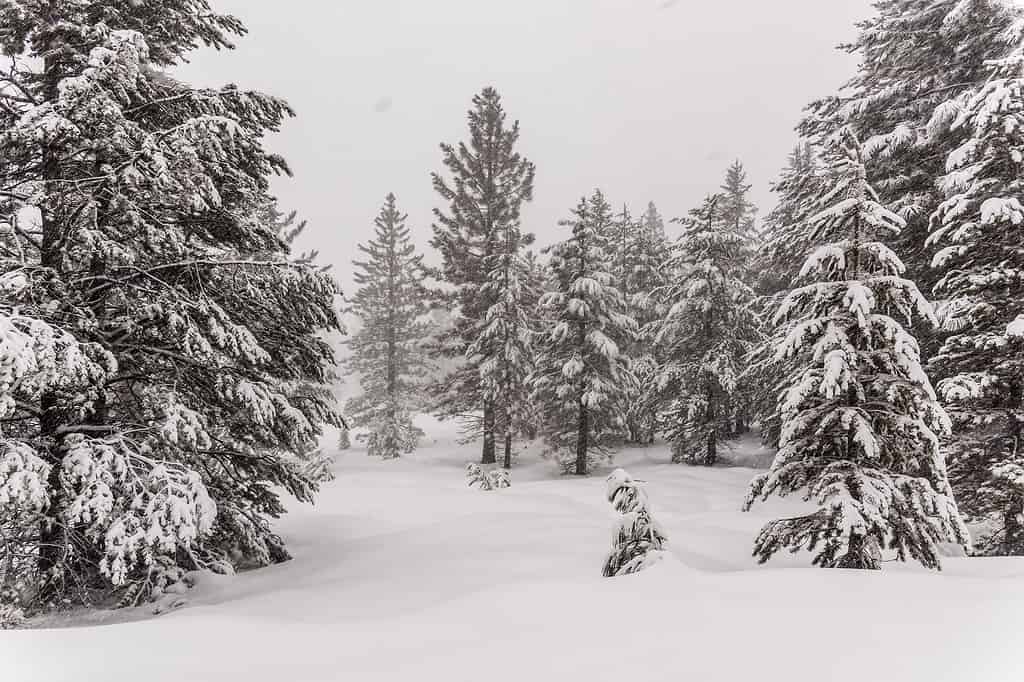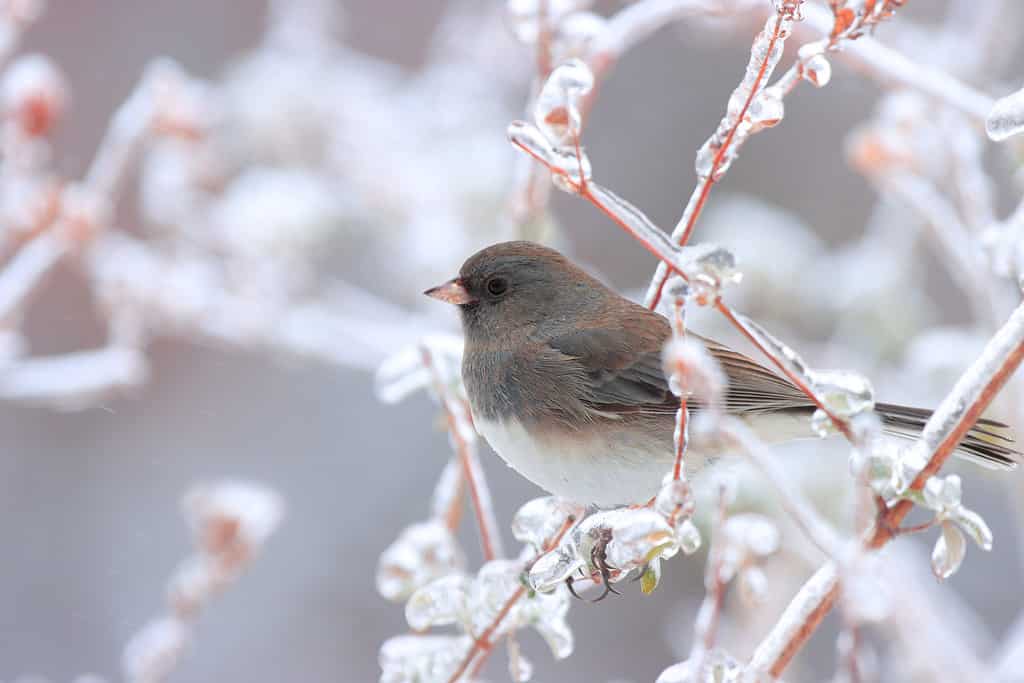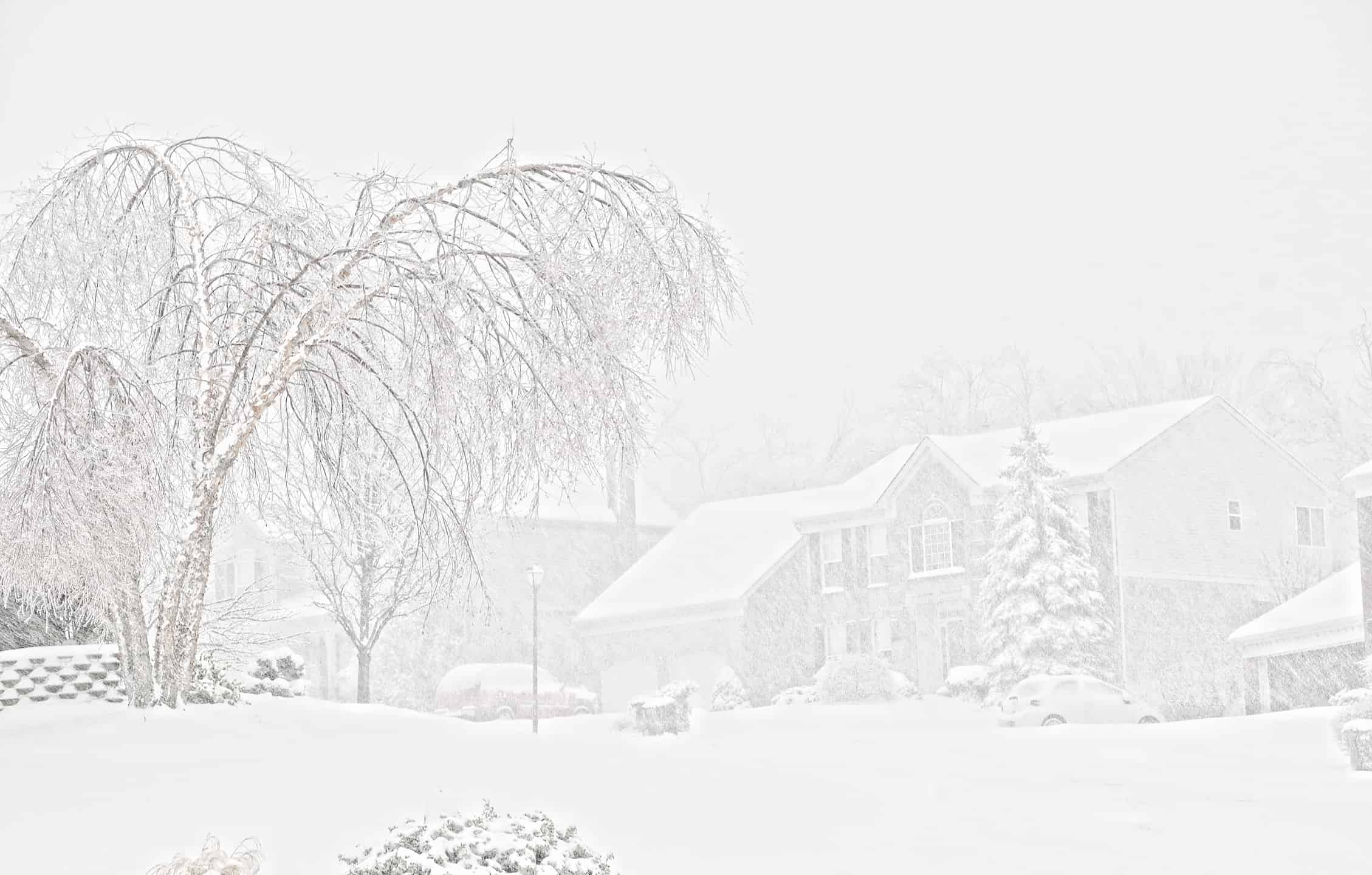Colorado weather is exciting and unique. When snow comes, it falls hard, causing a foot accumulation or more. In some years, massive snowstorms have crushed the state, disrupting everyday life for the residents and wildlife.
Official Denver meteorological records show that 96 Mays out of 137 have had measurable snow. There’s a noticeable increase in the frequency of snowstorms during the late spring season. Most of these May snowstorms in Colorado tend to be minor. However, a recent measurable snowfall happened on May 21, 2022, a 4-inch snowstorm and the latest in nearly 20 years. But this wasn’t the worst. The state once endured a massive May snowstorm, which threatened power lines and wildlife.
Let’s look at the massive snowstorm that crushed Colorado in May!

Colorado may experience a snowstorm in May, like the blizzard of 1898.
©iStock.com/Bill_Dally
What was the Massive Snowstorm that Crushed Colorado in May?
The massive snowstorm that crushed Colorado in May was the blizzard of 1898. The snowstorm kicked off on May 1 and lasted through May 5, a full five days, leaving a record 15.5 inches of snow. It is still the most massive May snowstorm in Denver’s history.
During those five days, the temperatures didn’t drop below 29 degrees. Two days after the snowstorm, nature took its course, and temperatures hit 65 degrees.
Impacts of the Massive Snowstorm of May 1-5, 1898
In the late 1800s, Denver’s population was minimal, with very little development. The storm was not well documented. However, great quantities of snow often lead to extensive tree damage, which may have been the case in May 1898.
In 1898, the state didn’t have today’s capacity to fight such massive snowstorms. So, the response may have been poor, failing to reach all parts of Denver. Furthermore, this massive snowstorm likely impacted the visibility of motorists, pedestrians, and animals.
Such a storm creates a massive accumulation of ice, which carries the following negative impacts:
- Poor visibility and the slipperiness on the roads can lead to tragic accidents.
- The proliferation of ice breaks down powerlines, leading to the disruption of power.
- Ice weighs down trees and branches break off.
- Communication cables aren’t spared from the weight of the ice.
- Ice accumulation may cover potentially hazardous obstacles, which can be dangerous to motorists, humans, and animals.
- Massive ice accumulation is costly to clear and disrupts everyday life.
What is May Weather Like in Colorado?
Typically, in May, temperatures in Colorado are comfortable, and it’s an ideal time to visit the state. It is the peak of the fishing season, and Colorado’s mountains are enjoyable. Waterfalls during this time of the year are at their peak, as river volumes increase due to melting Rock Mountain snow.
According to statistics, the daily high temperatures in Colorado range from 17.7 to 23.3 degrees Celsius.
However, they can rise to 29°C in warmer climates or fall to 10.5°C in cooler temperatures. Daily low temperatures average from 4.4 to 9.4 degree Celsius. Depending on weather conditions and elevation, temperatures may fall to -0.5°C .
Here is a summary of Colorado’s Weather in May Since 1872:
Coldest May in Colorado’s Weather History
| Fahrenheit | Celsius | Year |
|---|---|---|
| 48.7 | 9.3 | 1917 |
| 50 | 9.5 | 1995 |
| 50.1 | 9.6 | 1935 |
| 50.3 | 9.6 | 1907 |
| 51.4 | 9.8 | 1983 |
| 51.5 | 9.8 | 1892 |
| 52 | 9.9 | 1946 |
| 52.6 | 10.0 | 1967 |
| 52.7 | 10.1 | 1924 |
| 52.8 | 10.1 | 1943 |
| 52.9 | 10.1 | 1915 |
| 53 | 10.1 | 2015…1950…1898…1882 |
Warmest May in Colorado’s Weather History
| Fahrenheit | Celsius | Year |
|---|---|---|
| 64.7 | 12.4 | 1934 |
| 63.2 | 12.1 | 1994 |
| 62 | 11.8 | 1886 |
| 61.7 | 11.8 | 1958 |
| 61.6 | 11.8 | 1974…1879 |
| 61.5 | 11.7 | 1939 |
| 61.3 | 11.7 | 1936 |
| 61.1 | 11.7 | 1875 |
| 61 | 11.6 | 1941…1874 |
| 60.9 | 11.6 | 1963…1956 |
| 60.8 | 11.6 | 1881 |
| 60.7 | 11.6 | 1977 |
Snowiest May in Colorado’s Weather History
| INCHES | YEAR |
|---|---|
| 15.5 | 1898 |
| 13.7 | 1950 |
| 13.5 | 1978 |
| 13.2 | 1912 |
| 12.0 | 1917 |
| 10.0 | 1908 |
| 9.0 | 1907 |
| 8.9 | 1893 |
| 8.8 | 1957 |
| 8.3 | 1944 |
| 8.2 | 1979 |
| 7.8 | 1931 |
| 7.6 | 1983 |
| 7.4 | 1915 |
| 7.2 | 2001 |
The Least Snowy May in Colorado’s Weather History
| INCHES | YEAR |
|---|---|
| 0.06 | 1974 |
| 0.09 | 1886 |
| 0.15 | 1899 |
| 0.22 | 1919 |
| 0.34 | 1977…1966 |
| 0.43 | 1925 |
| 0.49 | 1972 |
| 0.52 | 1911 |
| 0.53 | 1900 |
| 0.60 | 1954…1921 |
| 0.64 | 1970 |
| 0.65 | 1984 |
| 0.68 | 1963 |
How Do Massive Snowstorms Impact Wildlife in Colorado?
Humans can stay inside where it’s warm, but animals aren’t so lucky. While we perceive wildlife adaptability and their thick fur coats as natural protection against adverse weather, in some cases, it’s inadequate. Survival depends on a constant balancing of competing needs.
Colorado is home to a variety of wildlife, including:
- Bison
- Elk
- Deer
- Black bears
- Mountain lions
- Foxes
- Rattlesnakes
- Wild horses
Because of Colorado’s climate and snowfall, the animals in the state have perfected living in cold temperatures. Instincts guide them to migrate according to changing weather patterns. Mountain animals start moving to lower elevations when it gets cold, but unpredictable snowstorms can result in some challenges.
Snowstorms early in the year make it difficult for wildlife to find suitable winter habitats. As a result, animals caught in the blizzard may perish due to exposure.
Such a massive snowstorm affects newborn wildlife, whose mortality rate is higher. For instance, elk calves and deer fawns may be abandoned as adults flee to seek shelter. Heavy snow also impacts short-legged animals when traversing through the thick layers of ice.
Another significant impact is human-wildlife conflict. As wildlife seeks more accommodating habitats, they come close to human-occupied spaces like roads. Elk, when the snow is high, tend to steal farmers’ hay, as they can’t find enough food.
Wildlife Benefiting from Extreme Cold Temperatures and Snow
Some animals in the Centennial State benefit from the cold weather. They can sense the changing weather patterns and prepare for the storm.
Moose are well adapted to live in the cold and benefit from freezing weather. Extreme low temperatures help moose by killing thousands of ticks in the animal’s hide. Ticks are a significant contributor to hair and blood loss for moose. The parasites may cause a moose to spend too much time grooming, leading to malnutrition.
Additionally, critters like pikas need deep snow to stay warm. Snow provides cover for pikas’ dens, which are generally under loose rocks. Without such covering, pikas, including their dwellings, are exposed to elements.
Wildlife Hibernating in Snowy Weather
Some of Colorado’s wildlife hibernate during winter. The animals enter a period of dormancy in a sleep-like state, lasting up to 200 days. Hibernating animals in Colorado include:
- Black bears
- Chipmunks
- Marmots
- Bats
- Garter snakes
However, some animals remain active in winter. They escape the freezing temperatures by burrowing. A good example is the pocket gopher. Red foxes also make dens in holes but can also use depressions underneath human structures.
Camouflaging Animals in Snow
Small mammals, like the snowshoe hare, have color-changing coats for camouflage. Their winter coats change from brown to white, giving them perfect camouflage against the snow.
Ermine, a member of the weasel family, also changes its coat color to white in winter. However, they are predators, and the white coat enables them to stalk prey on the snow-covered terrain.
How Do Big Game and Large Mammals Survive in the Snow?
Colorado’s big game and mammals are well-adapted to live in cold temperatures. Most, like elk, deer, and big horn sheep, live in higher elevations all year round. However, they exhibit a migratory pattern during winter and summer. Some accumulate fat in their body during warm weather for use during the colder season. Their thick fur coat also acts as insulation against freezing temperatures.
When the cold becomes unbearable, the animals seek habitats at lower altitudes. The animals usually migrate to slopes facing the south. The south-facing slopes offer more sunlight and abundant food sources due to shallow snow depth. Although the big game’s primary food source is grass, they feed on shrubs in winter.
Unfortunately, these large animals frequently use roadways for travel to and from pastures, increasing their chances of being hit by motorists.
How Do Birds Manage in the Snowy Weather?
Birds, unlike mammals, don’t store fat. Mainly, birds benefit from being fed by humans. Besides bird feeders, they can seek food from people’s berry-bearing plants and other grain crops.
The highest misfortune birds suffer in such blizzards is the destruction of their nesting places by the clinging heavy ice. Some die due to lack of shelter, starting with the chicks in ice-covered nests.

Birds’ nesting places are destroyed in snowstorms.
©Walter Coate/Shutterstock.com
Some birds, however, are migratory, like the dusky grouse. Also known as the blue grouse, these birds seek higher elevation during winter. In summer, dusky grouse live at heights of 7,500 feet but migrate to 10,000 feet during winter.
Birds also have physical adaptations that help them survive. Some insulate themselves by fluffing their feathers and slowing their metabolism at night. In addition, they group close to one another for body heat.
Can Humans Intervene for Wildlife Facing Snowstorms?
Colorado Parks and Wildlife intervene by conducting limited, small-scale big game baiting to lure wildlife away from human conflict. The baiting is temporary and can’t sustain the animals. Parks and Wildlife officials advise citizens to avoid feeding big game animals and recommend leaving it to the professionals.
Although humans mean well, wild animals’ digestive systems can’t cope with some of the feeds they offer. The desire to help can be harmful when the animals become more accustomed to humans. Another risky scenario involves predators growing attracted to humans’ habitats, turning to easier prey like pets and children.
So, let nature take its course, even if it’s hard to watch as wildlife succumbs to massive snowstorms. Wild animals tend to bounce back and multiply in a favorable climate. In the wild, the fittest survive to carry on the next generation.
Thank you for reading! Have some feedback for us? Contact the AZ Animals editorial team.








